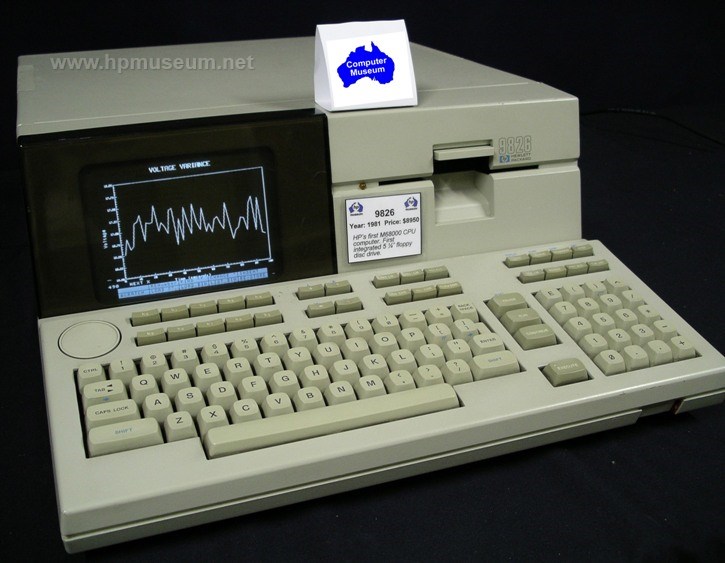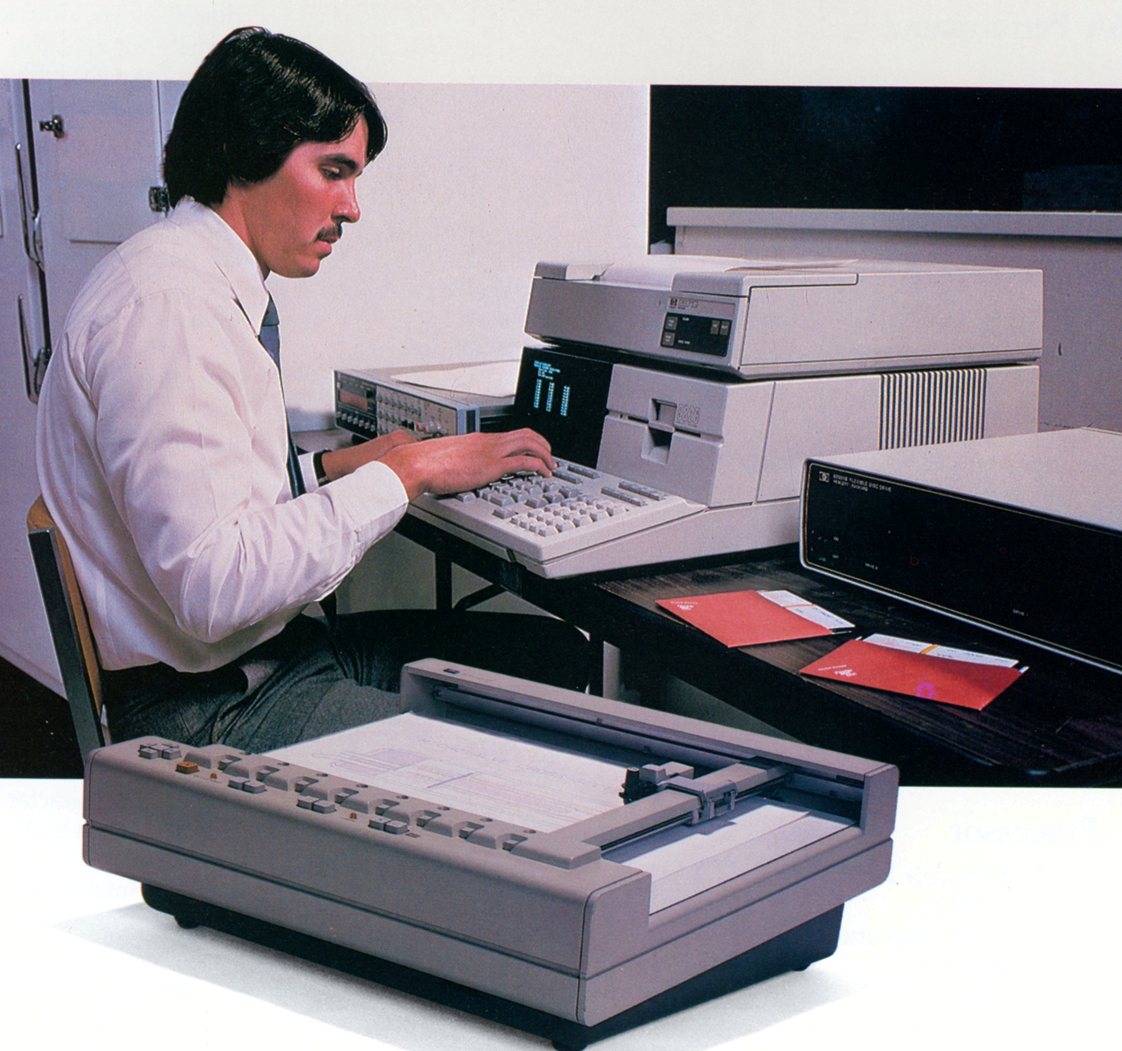Technical Desktops
 | 200 Series Selection: |
| Name: 9826A | |
| Product Number: 9826A | |
| Introduced: 1981 | |
| Division: Desktop Computer Division | |
| Ad: Click to see, Click to see, Click to see, Click to see | |
| Original Price: $8950 | |
| Catalog Reference: 1982, page 658 |
Description:
The 9826 was the first of the Series 200 machines. It came standard with a seven inch screen (300 x 400 dot resolution), 128K RAM and a single 5.25 inch floppy drive. The 9826 also had eight expansion slots. It was commonly used as an instrument controller. The 9826 family was also known as the 200 Series Model 26, 9000 Model 226 and 9000/226
In 1983, HP introduced a detachable keyboard option for the 9826A and 9836. This option (G3) was priced at $300 and only available in Europe.
The 9826A was very successful from the beginning of production. 295 units were sold during the first month (including 113 in Europe), a new record for HP desktop computers.
Be sure to visit Olivier De Smet's emulator project for 200 Series computers.
More info from Steve Leibson at www.hp9825.com on how the 9826 was developed follows:
The 9826 was the follow-on to the 9825. The 9825 was designed specifically for instrument control and used a 3-chip NMOS hybrid processor heavily based on the HP 21xx minicomputer instruction set. That same hybrid processor in modified forms was also used for the 9831, 9835, and 9845 desktop calculator/computers. All of these hybrid processors were made in HP Loveland's NMOS fab. (I've got an article about this period of history in EEJournal on May 1, 2023.)
By the end of the 1970s, that 21xx architecture was petering out, mostly due to the restricted address space, which started with 15 bits, got extended to 16 bits by killing the multiple-indirect feature, and then extended further with address space block switching in the 9835 and 9845 computers. The shortcomings of the architecture were apparent, as was the DC100 tape storage, which was already yielding to 5-1/4 inch floppies in competitive machines.
With Motorola's introduction of the 68000 microprocessor architecture, it was clear that merchant semiconductor makers could exceed the capabilities of the HP-grown 3-chip hybrid, so the 9825 follow-on instrument controller was designed with the 68000. In direct tests, the 68000 was clearly superior to the two competing 16-bit microprocessors of the day, the Zilog Z8000 and the Intel 8086. (The IBM PC was not due for another couple of years, and would select the cheapest processor, not the fastest.) The 9826 would also fix two major 9825 shortcomings: the single-line LED display would be replaced with a CRT and the tape drive would be replaced with a floppy drive.
The question of how big the CRT would be was solved by Tom Haswell, the Desktop Computer Division's Lab Manager. He was a big man, so he decreed that the physical envelope of the 9826 needed to fit under his arm, so he could carry it around. That precision specification determined the size of the CRT in the box.
The 9826 set the stage for the new family of HP Desktop Computers. The 9826 itself soon became the HP 9000 Series 200 Model 26. Same machine. New name. It featured many new capabilities thanks to the new hardware, but it still ran the HPL language, which originated with the 9820/21 and came to full flower in the 9825. This interpreted language proved very popular with engineers building rack-and-stack instrumentation systems. HP also introduced a version with dual floppy drives and a bigger CRT as a top-hat module called the 9836. Same underlying hardware.
Many new series were added to the HP 9000 line including the 500 series (Project Dawn), based on HP's homegrown, 32-bit FOCUS processor. The 500 series was a pretty awesome machine with a home-grown HP processor architecture that supported multiprocessing. It also became the first desktop computer that was so heavy that production had to install a small crane to put it into its shipping box. This computer became very popular with the US Navy because it was the most powerful computer that could be fit through the hatch of a nuclear sub. FOCUS was HP's next-to-last gasp with NMOS. The follow-on PA-RISC processor started as NMOS but quickly became a CMOS processor in subsequent versions, because CMOS processing had gotten fast enough to replace NMOS by then and consumed a lot less power.

Collector's Notes:
The museum has found 9826s to be very reliable. As of 2015, 80 percent of units we see have been fully functional, although broken keys are not uncommon.
Error 96 - The built-in floppy disc drive often needs some TLC to bring back to functioning order. The grease lubricant used on the mechanical parts of the drive can cause those parts to stick with age - this is particularly common for floppy drives made by Magnetic Peripherals Inc where a damping weight near the head carriage gets stuck in its sticky grease. This causes the 9826 to fail its power on test with an error 96 on the processor LEDs (or code 16 from the speaker beeps). This can be solved by cleaning with alcohol and replacing the grease with silicon oil. The read/write head of the drive also often needs cleaning in order to read discs. Clean the heads using a 5.25" head cleaning disc. Some functions of the computer may not work because the unit was dropped, unseating one or more of the internal PCBs. A good first step in refurbishing these computers is to remove the top case and re-seat all internal PCBs. The memory boards for the 9826 are very reliable. These boards all require specific dip switch settings depending on how much memory the machine has, so be sure to check the manual when adding or re-configuring memory.
Some 9826A computers are the only models in the 200 Series that we have seen that contain boot ROMs that precede version 3.0. The pre-3.0 boot ROM machines will only boot from the internal floppy drive (or pluggable ROM O/S) and not from an external HP-IB drive. The start up screen for these early models gives only a memory count and a message about finding (or not) an operating system. The start up screen for boot ROM 3.0 and later also provides information on the self test status of all plug in cards as well as the built-in HP-IB, floppy drive and keyboard.
| Back | More Images | Product Documentation | Category Accessories |
^ TOP©2004 - 2024 BGImages Australia - All Rights Reserved.
The HP Computer Museum and BGImages Australia are not affiliated with HP Inc. or with Hewlett Packard Enterprise. Hewlett Packard and the HP logo are trademarks of HP Inc and Hewlett Packard Enterprise. This website is intended solely for research and education purposes.
